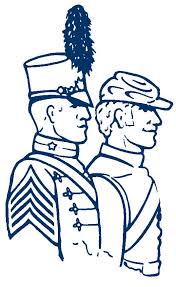Bulldog Gridiron Warrior Lost at Loos 1915
Yesterday, I was searching for articles about William Montague Nicholls, Class of 1912, the first Citadel Man killed in the First World War. A young man from Spartanburg, South Carolina, he left his father’s law practice in 1914 to join the war in Europe and served in the British Royal Field Artillery. While I found several news articles of interest, the one item that continues to elude me is a picture of him. There should be one of him in the Naval Academy’s 1914 Lucky Bag, but I have not yet found the senior class’s pages digitalized on the web. During his second year at The Citadel, he won an appointment to the Naval Academy at Annapolis, Maryland, and he joined its Class of 1914.
I did find the pages describing the 1913 Army-Navy football game at the Polo Grounds in New York City where “Monty” Nicholls quarterbacked the Navy team. There is a very blurry black and white photograph captioned with “Monty takes 40 yards”, but real details cannot be made out.[1] [Author’s note: Since the original posting of this article, I have found the Lucky Bag page… Montague’s senior page with photo.]
The article that caught my attention and imagination though was Wilton Garrison’s “Sports Shots” column printed the day before the Wofford College homecoming of 1934. Wofford, situated in Spartanburg, would play against The Citadel Bulldog football team.
25 YEARS AGO
We were talking with Perry Sessions [2] yesterday about football and he recalled The Citadel team of 25 years ago as one of the gamest and most courageous teams he had ever seen play. Squads were small in size and numbers in those days, but there was plenty of spirit: freshmen could play on the varsity then – and the coaches used them, too.
The Citadel team of 1909 was coached by the great Sam Costen, who was All-Southern quarter at Vanderbilt on a team that was undefeated and tied only by the Navy his senior year. That year (1909) The Citadel played Georgia and Davidson to 0-0 ties. Clemson put Rogers, star halfback out with a broken arm; Riddle, an end, had his arm wrenched. Montague Nicholls, a freshman and a fine end and punter, also had his arm broken; Montague was a brother of Sam J. Nicholls, Spartanburg attorney, [3] and was later a great quarterback at the Navy. Citadel lost to Clemson, 17-0 after these injuries.
Citadel played Carolina in Charleston and the patched-up Bulldog team lost to the Gamecocks, who had previously lost to Davidson by 29 to 5, after a hard fight by a score of 11 to 5. J. D. Parks, a Woodruff boy weighing only 150 pounds, played a great guard and was never substituted for all season. [4]
1909 was a year of firsts, and Montague, a freshman, was a part of that history. The 1909 team was the first to be officially called the Bulldogs, and their first ever road trip took place on November 3, 1909 to play Davidson at the County Fairgrounds in Orangeburg, S.C.
The 1909 Citadel football team’s record was 4-3-2 that year. Their two conference games that year were played against Georgia and Clemson. They also played their second ever away game at Parris Island, S.C. against the Parris Island Marines. Our Citadel Bulldogs lost 5-17. [5]
[Three Citadel Men of the Great War Remain in Europe]
In a 1915 news article titled “Many Noted Athletes Killed in European War”, Montague Nicholls is named along with some of the greatest athletes at that time. Here is an excerpt:
PRESENT day historians have made many prophecies concerning the effect of the war in Europe upon civilization. Ponderous documents have been written foretelling the number of years it will take to rebuild the cities, to restore the peaceful commerce of antebellum days and to pay off the monstrous debt incurred by the belligerents.
One phase of the grim, desperate struggle that has escaped notice in the more momentous questions of the day is the effect of the War upon athletics. The 1916 Olympics were scheduled for Berlin, but it is doubtful whether there will be any for many years to come, and it is likely that international tournaments will be called off until the places in the ranks of the noted athletes killed or incapacitated can be filled.
Johnny Poe, the Baltimore man killed at Loos recently, was probably the best known American athlete who gave his life to the war god. He was one of the most brilliant football players that have been produced by Princeton, and his death brought sorrow to the hearts of thousands. Montague Nicholls of Spartanburg, S.C., quarterback on the Navy football team in 1912 and 1913, is another well known American football player who has been lost. Like Poe, he met his death in the British offensive at Loos. [6]
The cable received by his family from the British war office in London read:
Deeply regret to inform you that Second Lieut. W. M. Nicholls, R. F. A., was killed in action between 26 – 27 September. Lord Kitchener expresses sympathy. [7]
Montague’s body was never recovered. His name is among the more than 20,000 carved into the Loos Memorial which surrounds Dud Corner Cemetery at Loos-en-Gohelle, France. The memorial and cemetery are maintained by the Commonwealth War Graves Commission.
/RL
[1] 1914 Lucky Bag article on the Army-Navy Game of 1913.[2] Col. F. Perry Sessions, Class of 1910, President of the Citadel Alumni Association 1930-32, and alumni member of The Citadel Board of Visitors during the 1940’s. List of CAA Past Presidents.
[3] Samuel J. Nicholls was a member of the U.S. Congress from 1915 – 1921. See Biography.
[4] The Spartanburg Herald, Spartanburg, S.C., Friday, November 2, 1934, p. 13, col. b.
[5] Wikipedia: The Citadel Bulldogs football 1905-1910.
[6] Auburn, New York, Citizen 1915
[7] The New York Times, October 1, 1915



Comments (0)